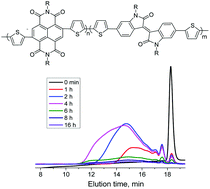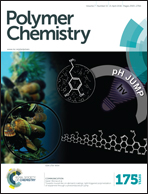Copolymerization of zinc-activated isoindigo- and naphthalene-diimide based monomers: an efficient route to low bandgap π-conjugated random copolymers with tunable properties†
Abstract
The present work aims at the extension of the scope of a recently discovered polycondensation of AB-type anion-radical monomers. To this end, we investigate the polymerization of isoindigo-based monomer and its copolymerization with the naphthalenediimide-based monomer. Although polycondensations of parent naphthalenediimide- and perylenediimide-based monomers involve chain-growth mechanism, we found that the corresponding isoindigo-based monomer polymerizes in a step-growth manner under the same reaction conditions. In contrast to Stille, Suzuki and direct arylation polycondensations which require prolonged stirring at high temperatures, the polymerization approach we employed in this study proceeds fast at room temperature. It was found that near statistical copolymerization of isoindigo-based anion-radical monomers with corresponding naphtalenediimide-based monomers proceeds smoothly resulting in a library of copolymers with varying composition and properties depending on the ratio of the monomers.


 Please wait while we load your content...
Please wait while we load your content...